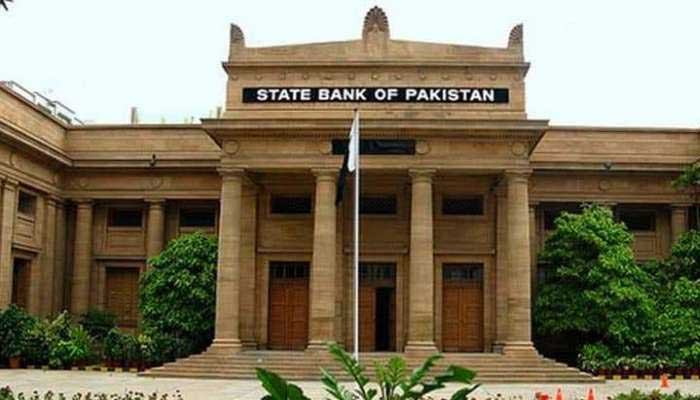Govt borrowing from SBP soars 119.3 percent in FY2019
KARACHI: Government borrowing from the central bank increased more than two-fold in the fiscal year 2018/19 as a drop in tax revenue failed to offset higher spending while authorities continued to rely on the State Bank of Pakistan’s (SBP) to fill budget deficit, latest data showed on Tuesday.
The SBP data revealed that the government borrowing during July 1, 2018 to June 28, 2019 stood at Rs3.156 trillion, up 119.3 percent, from Rs1.439 trillion in the previous fiscal year.The surge in the government borrowings was mainly due to fiscal imbalances on the back of weak revenue collection, inefficient and loss-making state owned enterprises, and hefty circular debt in the energy sector. Moreover, the higher government borrowing contributed to a rise in the public sector debt.
The country ran a budget deficit of Rs1.922 trillion or 5 percent of gross domestic product (GDP) in July-March FY19. The budget deficit is likely to increase to more than 7 percent of the GDP against a target of 5.1 percent fixed by the government for the FY19 amid a revenue shortfall.
The increasing expenditures with regard to interest payments, subsidies and defense purpose also continued to drag on public finances. Banks’ reluctance to lend to the government due to demanding very short maturities also forced the government to meet a large chunk of its spending requirements through the SBP’s financing during the period under review.
However, the government has decided to cut SBP’s financing for budget deficit during the current fiscal year. International Monetary Fund (IMF) in its recently released staff report said the government was committed to refrain from any new direct financing of the budget by the SBP and to gradually reduce the SBP stock of net government budgetary borrowing.
“Moreover, the SBP and the MoF [Ministry of Finance] have agreed to reprofile the stock of mostly short-term government debt held by the SBP into short- and long-term tradable instruments of various maturities (one, three, five, and ten years) at interest rates close to market levels,” the report said.
“This operation will take place before the adoption of the amended SBP Act and will support debt sustainability, reduce the government’s interest bill, and avoid crowding out of private credit,” the IMF said in the report.
The FY2020 budget targets a primary fiscal adjustment of 1.2 percent of the GDP underpinned by high-quality permanent revenue measures of 1.7 percent of the GDP.
According to IMF report, on the expenditure side, the budget now incorporates implicit subsidies in the power sector that in the past were not budgeted and had contributed to the build-up of circular debt.
-
 Why Claude Is Gaining Momentum In Revolutionizing The AI Landscape
Why Claude Is Gaining Momentum In Revolutionizing The AI Landscape -
 Cheaper Cars, Fewer EVs: Trump Administration Shifts ‘auto Policy’ Focus
Cheaper Cars, Fewer EVs: Trump Administration Shifts ‘auto Policy’ Focus -
 Meghan Markle Takes 'breadwinner' Role In Prince Harry's California Life
Meghan Markle Takes 'breadwinner' Role In Prince Harry's California Life -
 Type 2 Diabetes Hidden Trigger In Daily Food Revealed
Type 2 Diabetes Hidden Trigger In Daily Food Revealed -
 Vertical Tabs Coming To Google Chrome
Vertical Tabs Coming To Google Chrome -
 Jane Seymour Reveals THIS Beloved Romance Was 'worst-reviewed' Movie Ever
Jane Seymour Reveals THIS Beloved Romance Was 'worst-reviewed' Movie Ever -
 European Leaders Slam Trump’s Tariff Threat Over Greenland As ‘unacceptable’
European Leaders Slam Trump’s Tariff Threat Over Greenland As ‘unacceptable’ -
 Princess Eugenie Leaves Father Andrew 'devastated' With Big Step: 't's Brooklyn Beckham Level'
Princess Eugenie Leaves Father Andrew 'devastated' With Big Step: 't's Brooklyn Beckham Level' -
 Nova Scotia Snow Storm Warning Issued As Heavy Snow Moves In
Nova Scotia Snow Storm Warning Issued As Heavy Snow Moves In -
 Vancouver Canucks 2025-26 Season: Adam Foote’s Future Under Early Scrutiny
Vancouver Canucks 2025-26 Season: Adam Foote’s Future Under Early Scrutiny -
 Gabriel Diallo Vs Alexander Zverev: Rising Canadian Eyes Major Upset Opportunity
Gabriel Diallo Vs Alexander Zverev: Rising Canadian Eyes Major Upset Opportunity -
 Bo Nix Injury Update: Broncos Quarterback Fractures Ankle Against Bills
Bo Nix Injury Update: Broncos Quarterback Fractures Ankle Against Bills -
 Oilers Vs Canucks: Why Edmonton Is Without Leon Draisaitl
Oilers Vs Canucks: Why Edmonton Is Without Leon Draisaitl -
 49ers Crushed As Kenneth Walker III Leads Seahawks To 41-6 Win
49ers Crushed As Kenneth Walker III Leads Seahawks To 41-6 Win -
 Canadiens Star Lane Hutson Makes History With 100th NHL Assist
Canadiens Star Lane Hutson Makes History With 100th NHL Assist -
 Bridgerton’s Claudia Jessie Says Her Real-life Style Is Nothing Like Eloise’s
Bridgerton’s Claudia Jessie Says Her Real-life Style Is Nothing Like Eloise’s




